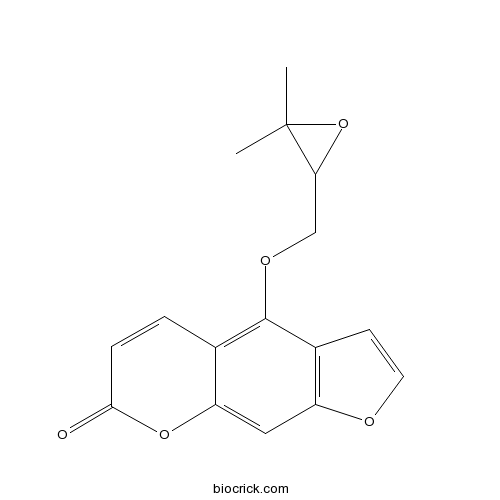InChI=1S/C16H14O5/c1-16(2)13(21-16)8-19-15-9-3-4-14(17)20-12(9)7-11-10(15)5-6-18-11/h3-7,13H,8H2,1-2H3
Oxypeucedanin is a major coumarin aglycone that can be extracted from Ostericum koreanum, coumarin aglycones have demonstrated various pharmacological effects, including anti-proliferation, anti-inflammation, and anti-pain; based on transcriptional alteration and complicated modulation of MAPK signaling, might be underlying mechanisms responsible for the various pharmacological effects of oxypeucedanin.[1]
Oxypeucedanina has a novel anticancer effect, mediated via induction of G2-M cell cycle arrest and apoptosis in human prostate carcinoma DU145 cells.[2]
Oxypeucedanin is a kind of open-channel blocker of the hKv1.5 channel and it prolongs the APD, therefore, it is an excellent candidate as an antiarrhythmic drug for atrial fibrillation.[3]
Oxypeucedanin and osthole have protective effects on doxorubicin -induced apoptosis in PC12 cells.[4]
Oxypeucedanin has hypotensive effects , the effect is related to dilate blood vessels.[5]
Oxypeucedanin has antidiarrheal and anti-inflammatory effects .[6]
English website: Oxypeucedanin
Japanese website: Oxypeucedanin
Chinese website: Oxypeucedanin
[1] Choi J S, Shin H Y, Kwon K S, et al. Planta Med, 2011, 77(13):1512-8.
[2] Kang T J, Lee S Y, Singh R P, et al. Acta Oncologica, 2009, 48(6):895-900.
[3] Eun J S, Park J A, Choi B H, et al. Biol Pharm Bull, 2005, 28(4):657-60.
[4] Moieniarya M, Shookohinia Y, Hosseinzadeh L, et al. Res Pharm Sci, 2012, 7(5).
[5] Tang C. Chinese Journal of Modern Applied Pharmacy, 1994(01):14-16.
[6] Zhang M, Shen Y. Chinese Traditional & Herbal Drugs, 1996(12):727-9.
[7] Paramapojn S, Gritsanapan W, Ganzera M, et al. Planta Med, 2008, 74(9):1089.



